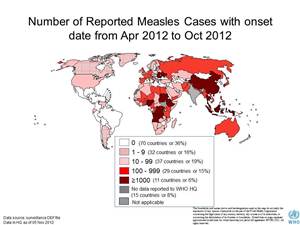Fresh off the heels of graduation, the Home Visit Strategy Field Officers are diligently on the move, testing their health and persuasive communication skills. As they implement our newly designed monitoring system, they begin to paint a real-time picture of community health and wellness.
These Field Officers are tasked with both observing and probing for information to understand their households’ current situations, and then using their findings to influence behavior and help troubleshoot maternal and child health problems. Despite their recent release from apprenticeship, both intuition and faculty kicked into high gear as several Field Officers working in the Nyametaburo Sub-location detected and reported a elevated incidence of what they identified as measles. News of these cases traveled swiftly from the field to the local Ministry of Health and the Kenya Medical Research Institute (KEMRI), which took quick action to collect blood samples and confirm the outbreak.
Our District Manager, Becky, and Training Manager, Robert, recognized an immediate need for informative resources and an emergency CUBIT (Continuous Capacity Building Training) about measles. What’s more is the fluidity of the communication and action taken in the absence of our in-country Program Manager, Claire Rumpsa. Claire has clearly made strides in preparing the team for full ownership of the program.
Becky requested Janine and my assistance in creating these materials. The timing could not have been better. Becky’s email landed in my inbox as I was participating in a TOPS Curriculum Development Summit. The module, Knowledge Sharing: Developing and localizing materials to empower Community Health Workers, had just reviewed Hesperian Health Guides’s new HealthWiki component.
Hesperian Health Guides is a nonprofit health information and health education source that supports individuals and communities in their struggles to realize the right to health. They develop easy to read materials that are produced in many languages. Now offering their content in a searchable wiki-based format, implementers can pull directly from their resources to create relevant tools for a particular program. The wiki is well suited for slow or intermittent networks and easy to adapt for local use. All open source, they also provide access to images to compliment the written component.
In about 10 minutes we had a thorough fact sheet ready to equip our Field Officers. Soon after, the team set out on a mission to halt this outbreak and prevent future occurrences by further promotion of one of our 10 Healthy Behaviors: Fully immunize children under 1 year old.

More than 95% of measles deaths occur in low-income countries with weak health infrastructures.[1] Measles is especially dangerous as complications include blindness, deafness, diarrhea and pneumonia, the leading cause of death of children worldwide. Vaccines are available at local health facilities, and increasing immunization coverage is a high priority for our Field Officers as according to our baseline data, full immunization for children under 1 year old is at a dismal 5.8%.
 Thanks to open-source materials like Hesperian’s we are able to be agile and prepared in times of need, and always have reliable resources to include in our base trainings. We look forward to bringing our field staff up to speed on how to take advantage of these user-friendly, comprehensive resources so materials can be created directly in the field.
Thanks to open-source materials like Hesperian’s we are able to be agile and prepared in times of need, and always have reliable resources to include in our base trainings. We look forward to bringing our field staff up to speed on how to take advantage of these user-friendly, comprehensive resources so materials can be created directly in the field.
[1] http://www.who.int/mediacentre/factsheets/fs286/en/

